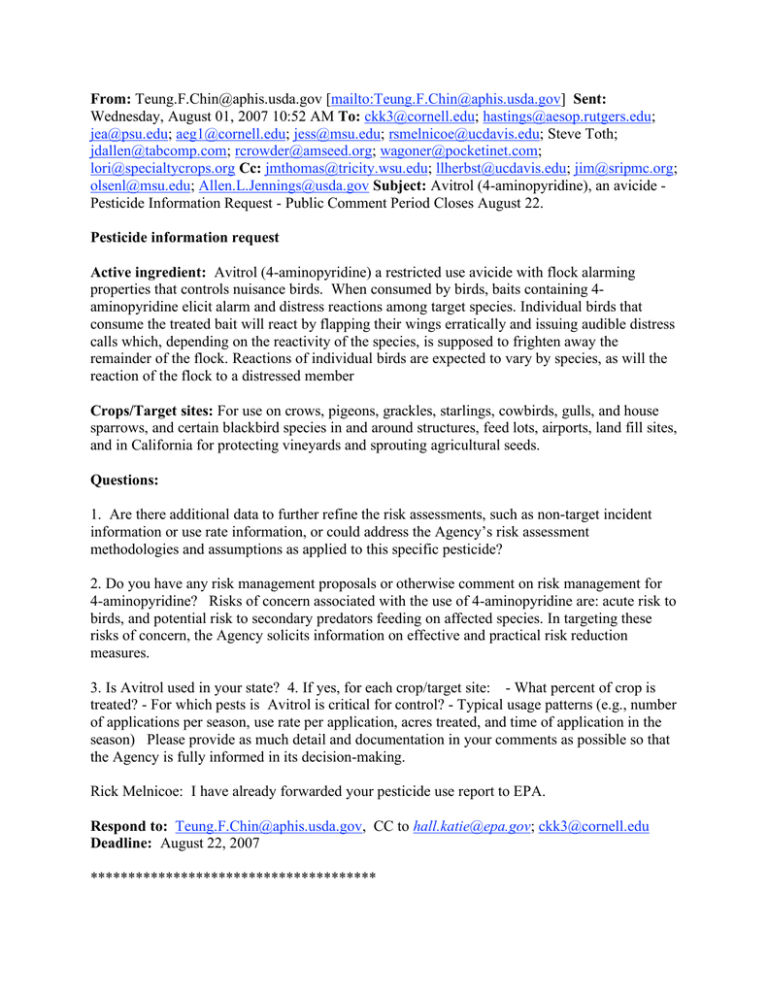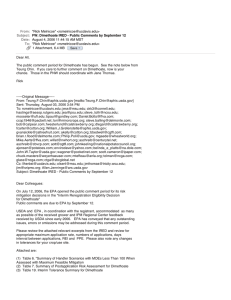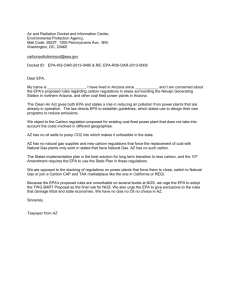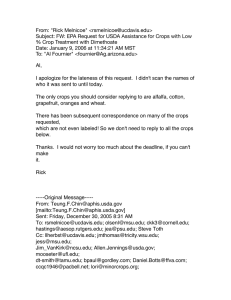From: Sent: To: ;
advertisement

From: Teung.F.Chin@aphis.usda.gov [mailto:Teung.F.Chin@aphis.usda.gov] Sent: Wednesday, August 01, 2007 10:52 AM To: ckk3@cornell.edu; hastings@aesop.rutgers.edu; jea@psu.edu; aeg1@cornell.edu; jess@msu.edu; rsmelnicoe@ucdavis.edu; Steve Toth; jdallen@tabcomp.com; rcrowder@amseed.org; wagoner@pocketinet.com; lori@specialtycrops.org Cc: jmthomas@tricity.wsu.edu; llherbst@ucdavis.edu; jim@sripmc.org; olsenl@msu.edu; Allen.L.Jennings@usda.gov Subject: Avitrol (4-aminopyridine), an avicide Pesticide Information Request - Public Comment Period Closes August 22. Pesticide information request Active ingredient: Avitrol (4-aminopyridine) a restricted use avicide with flock alarming properties that controls nuisance birds. When consumed by birds, baits containing 4aminopyridine elicit alarm and distress reactions among target species. Individual birds that consume the treated bait will react by flapping their wings erratically and issuing audible distress calls which, depending on the reactivity of the species, is supposed to frighten away the remainder of the flock. Reactions of individual birds are expected to vary by species, as will the reaction of the flock to a distressed member Crops/Target sites: For use on crows, pigeons, grackles, starlings, cowbirds, gulls, and house sparrows, and certain blackbird species in and around structures, feed lots, airports, land fill sites, and in California for protecting vineyards and sprouting agricultural seeds. Questions: 1. Are there additional data to further refine the risk assessments, such as non-target incident information or use rate information, or could address the Agency’s risk assessment methodologies and assumptions as applied to this specific pesticide? 2. Do you have any risk management proposals or otherwise comment on risk management for 4-aminopyridine? Risks of concern associated with the use of 4-aminopyridine are: acute risk to birds, and potential risk to secondary predators feeding on affected species. In targeting these risks of concern, the Agency solicits information on effective and practical risk reduction measures. 3. Is Avitrol used in your state? 4. If yes, for each crop/target site: - What percent of crop is treated? - For which pests is Avitrol is critical for control? - Typical usage patterns (e.g., number of applications per season, use rate per application, acres treated, and time of application in the season) Please provide as much detail and documentation in your comments as possible so that the Agency is fully informed in its decision-making. Rick Melnicoe: I have already forwarded your pesticide use report to EPA. Respond to: Teung.F.Chin@aphis.usda.gov, CC to hall.katie@epa.gov; ckk3@cornell.edu Deadline: August 22, 2007 ************************************** Background and additional information: On May 30, EPA released its ecological effects risk assessment for Avitrol and related documents for public comment. On July 25, the comment period was extended. Public comments on the risk assessment must be received by the EPA Public Docket by August 22, 2007 as part of its Reregistration Eligibility Decision (RED) for the pesticide. All the EPA risk assessment documents may be reviewed in the EPA docket under Docket Identification Number "EPA-HQ-OPP-2005-0400" at http://www.regulations.gov. Enter the Docket identification Number into the appropriate space in the "Advanced Search" tab and in the "Docket ID" space. To submit comments to the docket, see the May 30 Federal Register http://www.epa.gov/fedrgstr/EPA-PEST/2007/May/Day-30/p10228.htm. If you submit comments directly to the EPA public docket [Docket Identification (ID) number EPA–HQ– OPP–2005–0400] , please also send a copy to teung.f.chin@usda.gov and Katie Hall at hall.katie@epa.gov [703/ 308-8090] that USDA and EPA may better coordinate. For more information: See attached file: 1. Avitrol-Ecological-Effects-EPA-HQ-OPP-2007400 2. 2005 New England Sweet Corn Survey Results by the New England Pest Management Network [already provided to EPA] http://72.14.205.104/search?q=cache:gAJm88s44FkJ:pronewengland.org/INFO/PROpubs/Surv ey/SweetCornSurveyResultTables.pdf+avitrol+usda&hl=en&ct=clnk&cd=112&gl=us 5% of sweet corn growers (11 of 754) in New England are using avitrol bait in a 2004 survey undertaken by the New England Pest Management Network funded by the USDA Northeast Pest Management Center Please do not hesitate to contact me if you have any questions or comments. Best regards, Teung ~~~~~~~~~~~~~~~~~~~~~~~~~~~~~~~~~~~~~~~~~~~~~ Teung F. Chin, Ph.D. Biological Scientist Office of Pest Management Policy Agricultural Research Service United States Department of Agriculture PLEASE NOTE NEW ROOM LOCATION LOCATED AT: USDA Animal & Plant Health Inspection Service 4700 River Road, Unit 149 (Room 3D-06.29) Riverdale, MD 20737-1237 Phone (301) 734-8943 Fax (301) 734-5992 Teung.F.Chin@usda.gov http://www.ars.usda.gov/opmp ~~~~~~~~~~~~~~~~~~~~~~~~~~~~~~~~~~~~~~








